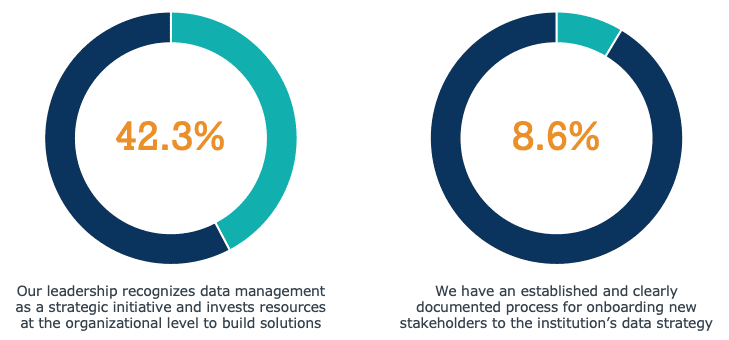Where are the gaps in your data strategy?
What we’ve learned from surveying 336 higher ed data users and stewards
July 29, 2022, By Maggie Dwyer, Strategic Leader, Data and Analytics
In the past year, my team has conducted in-depth audits of eight institutions’ data strategies through our work with Edify. In total, we surveyed 336 data stakeholders at these colleges and universities, from analysts to the cabinet, about their culture and practices regarding data. Some common themes emerged: while schools are hyper-focused on using data to improve student experiences and outcomes and making data-informed decisions a reality, inefficiency and poor utilization often get in the way.
Read on to explore what we found and learn what you can do if these gaps exist on your campus.
10 elements of effective data management
-
Organizational Culture
- Strategic vision
- Data culture
- Data governance structures
- Organizational continuity efforts
- Collaboration framework
-
Implementation practice
- Implementation strategy
- Common data dictionary
- Data quality assurance
- Data access management
- Data consumption
4 Common Data Strategy Issues
1. Communicating a vision
While many survey respondents agreed that data management is a strategic initiative their leadership is investing in, few agreed that their institution had a clear process for onboarding new stakeholders to the institutional data strategy. Without clearly documenting processes and standards around data management, staff turnover can easily slow or even undo your progress.
To what extent do the following statements describe your institution?
% of respondents who said “very well” or “fairly well”
-
What you can do
First, document expected standards, community guidelines, business processes, and roles and responsibilities around data management for your institution. Then, embed these into onboarding and training to ensure that everyone is on the same page when it comes to your data strategy. This could be in the form of a presentation during the first few months at the institution, a set of resources, or an online learning path.
Check Out Our Guide to Making the Case for Data Governance Work
2. Fostering a culture of shared ownership
One of the biggest discrepancies in our survey was respondents’ views of data ownership. When asked whether data is treated as an institutional asset (as opposed to being owned by individuals or departments), 32.4% of respondents said their institution did this fairly well or very well, while an almost equal 31.8% said their institution did this poorly or not at all.
Shared ownership is crucial to effective data use—everyone at the institution needs to understand what role they play in the data lifecycle and how their actions impact not only data quality and trust, but decision making using that data. Data should be seen as an institutional asset, and not something that belongs to any one individual. Everyone has a role to play and should be held accountable.
To what extent does the following statement describe your institution?
“Data is treated as an institutional asset and as such is not owned by individuals or departments, but by the institution collectively.”
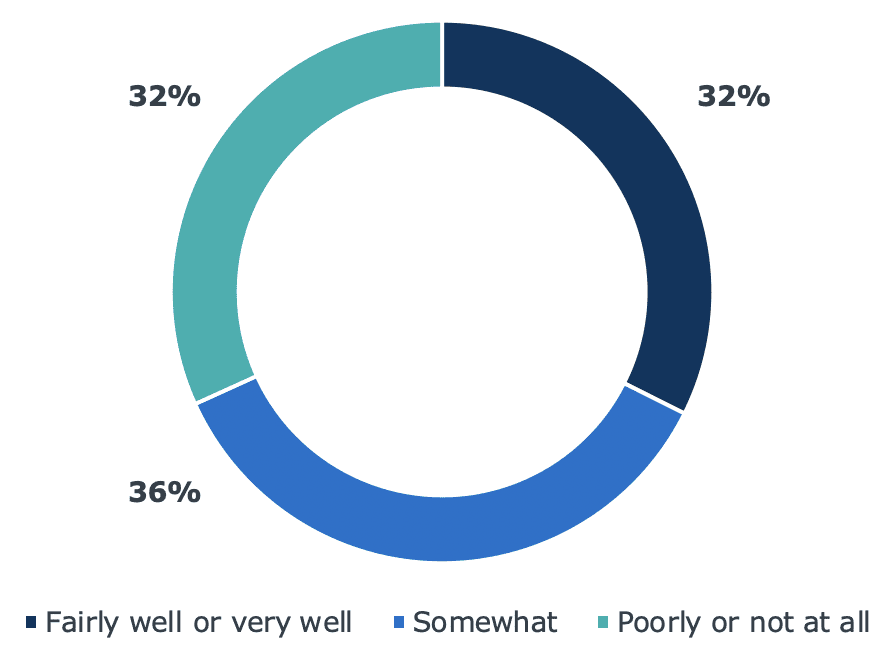
-
What you can do
Educate campus on the data lifecycle, from data creation to aggregation to use. Many people who interact with data at the creation stage may not be aware of all the ways in which it is used. By painting this larger picture, you can work towards a shared understanding of data as an institutional asset. Investing in data quality and effective data management should be seen as an institutional investment, not something that any one department is doing on their own.
Collaborating Across the Data Lifecycle: Get the Diagnostic
3. Granting appropriate access
Another place respondents disagreed was whether stakeholders have appropriate access to campus data. Though not quite as polarized as the shared ownership question, 25% of respondents said their institution granted appropriate access poorly or not at all, while 33% said their institutions did this fairly well or very well. Differences in level can contribute to this disagreement: one level of the organization may find it easy to get access to data while others are waiting weeks for data.
To what extent does the following statement describe your institution?
“Institutional stakeholders and data consumers have appropriate role-based access to shared campus data sets.”
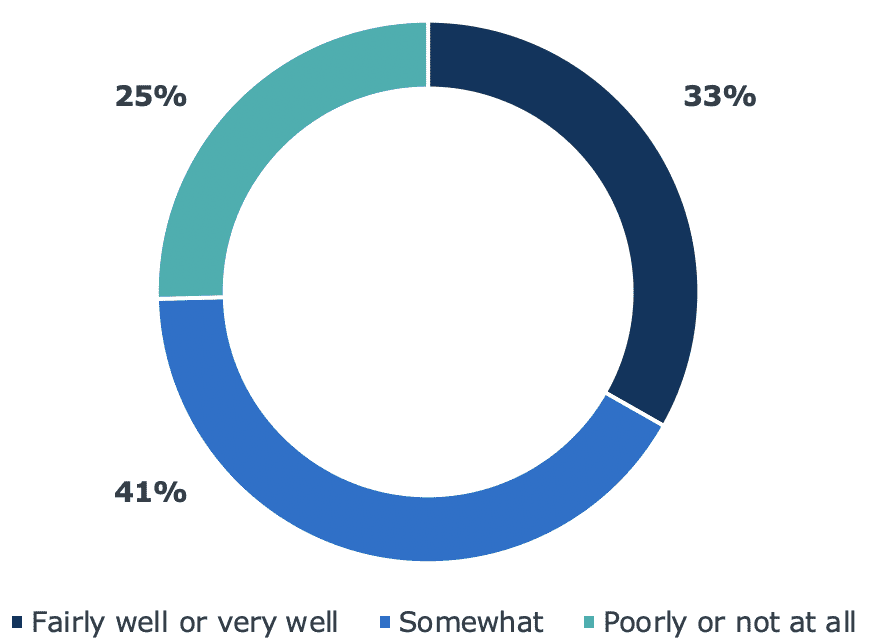
-
What you can do
To improve perceptions around data access, institutions should look to streamline the process for requesting and granting access based on role and allow for exceptions based on the intended use case. In addition, institutions should be looking for more efficient ways for users to get access to real-time data they need to make decisions.
Data Aspirations & Frustrations: Check Out the Infographic
4. Defining your terms
A data dictionary is a common source of record for your campus’s data terms. For it to be effective, it needs to be easily accessible to both technical and non-technical data users. In our survey, “common data dictionary” received the lowest performance score of all 10 data management practices, with most cabinet members, administrative and academic directors, and analysts rating their institutions’ performance as poor or only somewhat effective.
Creating a data dictionary can seem like an overwhelming project, but without it, competing narratives can emerge and erode trust in your data. For example, without a clear definition of what constitutes an academic program, you could get different numbers on how many programs are offered at the institution depending on what data system you pull from.
To what extent does your institution meet the following objectives for effective data management?
(Scale: 0 to 4, with 0 being “not at all” and 4 being “very well”)*
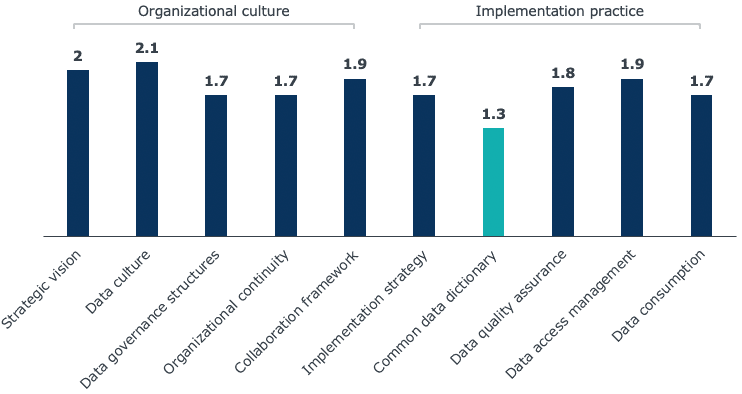
*Participants could also select “I don’t know”
-
What you can do
For those who are overwhelmed by the thought of creating an institutional data dictionary, we recommend starting with one functional area of data on campus. This is a great initial project for a data governance committee to take on. When defining terms, keep in mind any data definitions your institution must use for mandated state or federal reporting.
How do senior leaders’ perceptions compare?
Senior leaders gave lower scores on all elements of data management. This could reflect that, like many in higher education, they are trying to make decisions using data and finding it difficult. It could also mean they aren’t necessarily seeing the steps that analysts and others closer to data creation and aggregation are taking to improve campus data management.
To avoid this misalignment, we recommend data strategy and governance committees operate in a bicameral committee structure with a data strategy committee and a working committee. The data strategy committee is composed of senior leaders on campus and is responsible for setting the strategic direction of the working group. Through this structure, you can ensure that senior leaders and those closer to the data are in sync and aware of any barriers to success along the way.
To what extent does your institution meet the following objectives for effective data management?
(Scale: 0 to 4, with 0 being “not at all” and 4 being “very well”)*
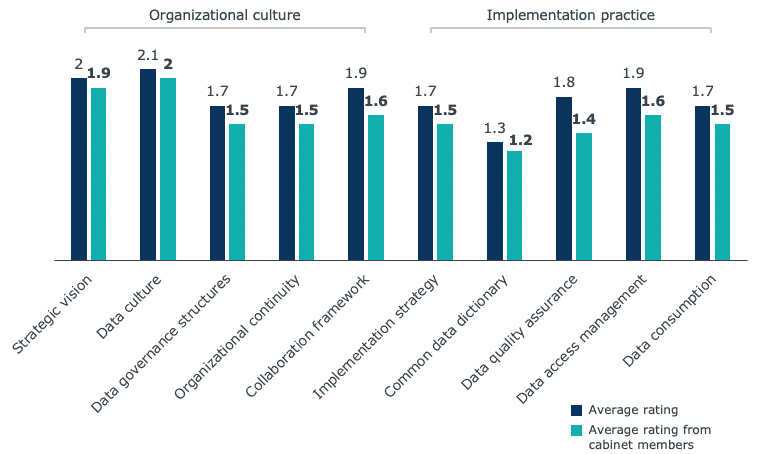
*Participants could also select “I don’t know”
Building a data foundation is more urgent than you may think
When we ask institutions what their top priorities are across the next year, the answers range from increasing enrollment to addressing equity gaps in retention to creating efficient business processes for a more financially sustainable institution. Underlying all these goals is access to data that will provide insight into how the institution can be more strategic, focused, and efficient. Without a solid data foundation, barriers like the ones I’ve outlined above are sure to get in the way of progress.
But Rome wasn’t built in a day, and neither was any good enterprise data foundation. To manage campus data effectively-so it’s ready to support the decisions you need to make-is to engage in continuous iteration and improvement. In the past, institutions may have been able to get away with not having a proper data strategy and implementation plan, but if the pandemic has taught us anything it’s that institutions have to be nimble and ready to make quick decisions at any time. Having data that you can trust, access, and analyze to inform those decisions is more important now than ever.

More Blogs

3 reasons your colleagues don’t want to use data—and how to change their minds

Creating a data-informed campus: part 1

